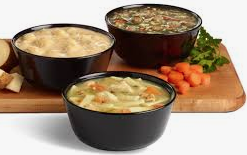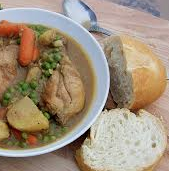Pay no attention to the hype surrounding the holidays, turn your phone off, light the holiday candles, and curl up with a warm bowl of soup and a good book.
That used to be the way to decompress, but with 24-hour access, the need and the urge to interact is incredibly strong.
Beginning even before Thanksgiving, and extending through January 1, there is very little downtime. Short of hibernation, most of us will be on the hamster wheel most of the time and catching our breath the next. Still, there is no reason not to curl up with that bowl of soup, because in reality soup solves both of our holiday issues.

Sustenance around the holidays can veer into some dangerous areas, including high-calorie fast food, candy for dinner, and late night trips to the leftovers part of your fridge. Holiday gatherings are wonderful for their social aspects, not so good when we fill up on crab dip and sliders. A home-cooked meal is epitomized by three iconic days; Thanksgiving, Christmas Day, and New Year’s Eve, not exactly the time to serve soup and bread.
So all the other days and nights in between have to balance the dietary minefield that holidays create, and offer relief from the obvious time crunch we all feel.
A bowl of soup or a quick stew can contain the highest amount of nutrients you could get in a day. Proteins, carbohydrates, vitamins and yes even fat can all be found in one package versus a whole plate.
Made on one afternoon it can provide a lunch next day, dinner with a green salad, even a late night snack with some crackers. Missing is the rush to find enough nutritional balance to keep you healthy while not skimping on flavor and enjoyment.

The other compelling issue is time or lack thereof. It’s why most of us feel the need to grab and go, giving rise to a whole new concept of service. The trick is to choose wisely and get an entrée that won’t bust the budget or the diet.
We do a lot of carryout at The Sage Rabbit and I’m always careful to cook and pack each to go container with a thought to the end of the journey. What will those fries be like a few minutes from now? Of course, we make sure items like that get prepared last, but I want my burger at the bunny, fresh and hot.
I look for soups, stews, beans and rice from our neighbors, Bourbon and Toulouse, even pasta that I know will reheat well. It will never equal the in-home or in-place dining experience, but it will save you time. Even more, time is saved in the home with a bit of planning. It starts with a shopping list and a stocked pantry. It also requires some discipline on your part to set aside time and energy to prep some items. That block of time is best carved out of the same day every week. Could be Saturday or Sunday morning, late Sunday afternoon or even a Monday night.

The reason behind this theory extends into our daily routine and the fact that we are more likely to continue if it becomes part of that daily routine. Doing it just when we feel the urge often leaves us hanging, especially when we have a million other things to do. Have a stocked pantry, we’ve talked about that in many a column. Stock basics, canned tomatoes, beans, dry pasta etc. Frozen peas and even frozen spinach are much more versatile than trying to keep and use fresh product. Any canned or frozen items from your garden are essential to keep a connection with local ingredients, but remember, the markets are still available to you as well, so stop down and check it out.
Consider all this to be a reminder that there are ways to keep it fresh, keep it local and keep yourself safe with a little planning and discipline. The first test is upon you; Thanksgiving leftovers.
I know the last thing you want to do is deal with leftovers, but consider the number of meals in December that can come out of one day in November. Stock and gravy, cranberry relish, turkey and even vegetables can all be preserved in various ways. Freezing is the most efficient way to keep items, but you need to start the process quickly. Use the carcass for stock, make it and freeze it within a day or two and store it in quart containers. Take the cooked meat and dice it up. If you have the time, freeze it in the stock to save steps when you make the soup. I freeze dressing for use in a roast chicken, and I’ll cook down the cranberry relish into a thick jam and store that in a Mason jar for toast or for a nice acidic flavor in another sauce.
The list can go on, but the main goal is to process all of the usable products quickly and with future use in mind.
Do this starting at Thanksgiving and you may be able to claim a small slice of time back during this busy holiday season.

John Foster is an executive chef who heads the culinary program at Sullivan University’s Lexington campus. A New York native, Foster has been active in the Lexington culinary scene and a promoter of local and seasonal foods for more than 20 years. The French Culinary Institute-trained chef has been the executive chef of his former restaurant, Harvest, and now his Chevy Chase eatery, The Sage Rabbit.
To read more from Chef John Foster, including his recipes, click here.
























